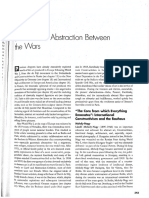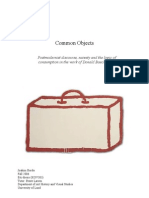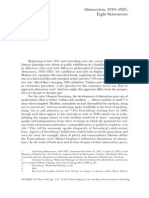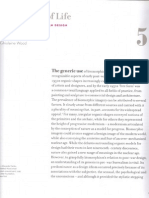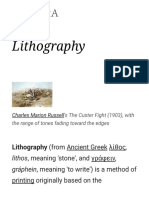Idesignsetter at Minimalism
Idesignsetter at Minimalism
Uploaded by
dilystorosian00Copyright:
Available Formats
Idesignsetter at Minimalism
Idesignsetter at Minimalism
Uploaded by
dilystorosian00Original Title
Copyright
Available Formats
Share this document
Did you find this document useful?
Is this content inappropriate?
Copyright:
Available Formats
Idesignsetter at Minimalism
Idesignsetter at Minimalism
Uploaded by
dilystorosian00Copyright:
Available Formats
idesignsetter @ Minimalism
Source link Term used in the 20th century, in particular from the 1960s, to describe a style characterized by an impersonal austerity, plain geometric configurations and industrially processed materials. It was first used by David Burlyuk in the catalogue introduction for an exhibition of John Grahams paintings at the Dudensing Gallery in New York in 1929. Burlyuk wrote: Minimalism derives its name from the minimum of operating means. Minimalist painting is purely realisticthe subject being the painting itself. The term gained currency in the 1960s. Accounts and explanations of Minimalism varied considerably, as did the range of work to which it was related. This included the monochrome paintings of Yves Klein, Robert Rauschenberg, Ad Reinhardt, Frank Stella and Brice Marden, and even aspects of Pop art and Post-painterly Abstraction. Typically the precedents cited were Marcel Duchamps ready-mades, the Suprematist compositions of Kazimir Malevich and Barnett Newmans Abstract Expressionist paintings. The rational grid paintings of Agnes Martin were also mentioned in connection with such Minimalist artists as Sol LeWitt. After the work of such critics as Clement Greenberg and Michael Fried, analyses of Minimalism tended to focus exclusively on the three-dimensional work of such American artists as Carl Andr, Dan Flavin, Donald Judd, LeWitt, Robert Morris and Tony Smith, although Smith himself never fully subscribed to Minimalism. These artists never worked or exhibited together as a self-defined group, yet their art shared certain features: geometric forms and use of industrial materials or such modern technology as the fluorescent electric lights that appeared in Flavins works. Minimalists also often created simple modular and serial arrangements of forms that are examples of Systems art. LeWitts serial works included wall drawings as well as sculptures. Judd and Morris were the principal artists to write about Minimalism. Judds most significant contribution to this field was the article Specific Objects (1965). Judds article began by announcing the birth of a new type of three-dimensional work that could not be classified in terms of either painting or sculpture and, in effect, superseded both traditions. Judds concept became retrospectively identified with his own boxes and stark geometric reliefs of the period . Originally, however, he explained his idea with reference to the work of a heterogeneous selection of artists, including Lee Bontecou, John Chamberlain, Klein, Yayoi Kusama (b 1929), Claes Oldenburg, Richard Smith, Frank Stella and H. C. Westermann (192281). The article was also copiously illustrated with works by such artists as Richard Artschwager, Flavin, Jasper Johns, Phillip King, Morris, Rauschenberg, Stella, and with one of Judds own pieces. Judd distinguished the new work by means of its compositional wholeness, which, unlike previous art, was not made part by part, by addition. He was later to focus the critical implications of this distinction with a dismissive reference (1969) to the Cubist fragmentation of Anthony Caros work. For Judd, his own work achieved its formal integrity principally by adapting into a third dimension the singleness that he observed in the compositions of such painters as Barnett Newman, Jackson Pollock, Mark Rothko and Clyfford Still. Morriss influential Notes on Sculpture appeared a year after Judds article. In it he established the criteria by which his own recent work could be evaluated. Like Judd, he repudiated an aesthetic based on Cubist principles. The sensuous object, resplendent with compressed internal relations, has had to be rejected (Artforum, v/2 (Oct 1966), p. 23). In its place Morris proposed a more compact, unitary art form. He was especially drawn to simple, regular and irregular polyhedrons. Influenced by theories in psychology and phenomenology, Morris argued that these configurations
established in the mind of the beholder strong gestalt sensation, whereby form and shape could be grasped intuitively. Judd and Morris both attempted to reduce the importance of aesthetic judgement in modernist criticism by connecting the question of the specificity of the medium to generic value. Nevertheless, a distinction between the categories of art and non-art was maintained with Judds claim that A work needs only to be interesting. For Greenberg and Fried, Minimalist work was united by the threat it posed to their modernist aesthetic. The modernist response to Minimalism was outlined in Greenbergs Recentness of Sculpture and Frieds Art and Objecthood (both 1967). Both critics were troubled by claims for Minimalism as a new art form, and were also concerned at the Minimalist elimination of complex compositional relations and subtle nuances of form, which they believed to be essential qualities of modernist sculpture. The critical resistance that Minimalism met in its initial stages persisted, and censure arose not only from modernist critics but also from the tabloid press. This was particularly evident in the abuse that was given to Andrs sculpture made from building bricks, Equivalent VIII (1966; London, Tate), upon the occasion of its exhibition at the Tate Gallery in London in 1976. From the 1960s the Minimalists work remained remarkably consistent, continuing its geometric and serial forms (e.g. LeWitts Cube Structures Based on Five Modules, 600800700 mm, 19714; Edinburgh, N.G. Mod. A.). Conceptual art inherited many of the concerns as well as the contradictions of Minimalist discourse. Attempts were made by Joseph Kosuth, among others, to resolve its complex views on the relationship between aesthetic judgement and the art object. Minimalisms sense of theatricality stimulated much subsequent work in the fields of installation and performance art, where it helped facilitate a critical engagement with the spectators perception of space and time. The concept of theatricality was first used in connection with Minimalism by Michael Fried to characterize the absence of presentness in the spatial and temporal experience of the art work. While Fried was critical of this situation, his analysis led, by default, to a reassessment of Minimalism from an anti-humanist perspective.
You might also like
- Buchloh - Formalism and HistoricityDocument17 pagesBuchloh - Formalism and HistoricityPol Capdevila100% (2)
- Adventure Time Chibi AmigurumiDocument15 pagesAdventure Time Chibi Amigurumimonidani35100% (8)
- Warren Carter Renew Marxist Art History PDFDocument1,031 pagesWarren Carter Renew Marxist Art History PDFShaon Basu100% (5)
- As You Like It PDFDocument36 pagesAs You Like It PDFching chang chungNo ratings yet
- Poland (Eyewitness Travel Guides) PDFDocument378 pagesPoland (Eyewitness Travel Guides) PDFionut nicolae100% (4)
- Minimalism ReportDocument12 pagesMinimalism ReportmizanNo ratings yet
- R. Krauss - Perpetual InventoryDocument6 pagesR. Krauss - Perpetual InventoryAndré Castanho100% (2)
- Chiao Mei Liu Brice MardenDocument34 pagesChiao Mei Liu Brice MardenŽeljkaNo ratings yet
- HH Arnason - International Abstraction BTW The Wars (Ch. 17)Document28 pagesHH Arnason - International Abstraction BTW The Wars (Ch. 17)KraftfeldNo ratings yet
- HH Arnason - Abstract Expressionism and The New American Art (Ch. 19)Document36 pagesHH Arnason - Abstract Expressionism and The New American Art (Ch. 19)KraftfeldNo ratings yet
- If You Give A Moose A MuffinDocument21 pagesIf You Give A Moose A MuffinAlex MoreraNo ratings yet
- MinimalismDocument8 pagesMinimalismkgaviolaNo ratings yet
- Lec 11Document5 pagesLec 11Ubaid KhanNo ratings yet
- MinimalismDocument6 pagesMinimalismAyesha RiazNo ratings yet
- Minimalism ArhitecturalDocument6 pagesMinimalism ArhitecturalcarmentrifNo ratings yet
- Art MovementDocument8 pagesArt Movementrabia wahidNo ratings yet
- HH Arnason - The Pluralistic 70s (Ch. 24a)Document32 pagesHH Arnason - The Pluralistic 70s (Ch. 24a)KraftfeldNo ratings yet
- Minimal Art NodrmDocument100 pagesMinimal Art NodrmXUNo ratings yet
- October No 136 Spring 2011 The New Brutalism 1Document220 pagesOctober No 136 Spring 2011 The New Brutalism 1José Raposo100% (1)
- The Cube in Minimalist Art PDFDocument14 pagesThe Cube in Minimalist Art PDFBradley CzovNo ratings yet
- Drawing Done With Intellectual Care Davi PDFDocument9 pagesDrawing Done With Intellectual Care Davi PDFelstaquioNo ratings yet
- ConstructivismDocument2 pagesConstructivism201961-studentNo ratings yet
- Cooper, IvyDocument11 pagesCooper, IvyMarshall BergNo ratings yet
- Turning The Display Into An ArtDocument4 pagesTurning The Display Into An ArtArchisculpture PlatformNo ratings yet
- Abstract ExpressionismDocument13 pagesAbstract Expressionismapi-193496952100% (1)
- Modern Times: Responding To Chaos: Drawings and Films Selected by Lutz BeckerDocument23 pagesModern Times: Responding To Chaos: Drawings and Films Selected by Lutz BeckerLvis GNo ratings yet
- Abstract ExpressionismDocument14 pagesAbstract ExpressionismsubirNo ratings yet
- Russian ConstructivismDocument3 pagesRussian ConstructivismSaurav ShresthaNo ratings yet
- Marx and IdeologyDocument3 pagesMarx and IdeologyhiNo ratings yet
- J.borda - Ba ThesisDocument28 pagesJ.borda - Ba ThesisCecilia BarretoNo ratings yet
- ModernismDocument73 pagesModernismMa Angely Amador100% (1)
- Chapter34 Art HistoryDocument14 pagesChapter34 Art HistoryMokutaiNo ratings yet
- Rosalind E. KraussDocument6 pagesRosalind E. KraussKarina Alvarado MattesonNo ratings yet
- Wikipedias Art CriticismDocument5 pagesWikipedias Art CriticismDumaGabrielNo ratings yet
- What Is Abstract ArtDocument3 pagesWhat Is Abstract ArtBermejo, Rhona Rose C.No ratings yet
- Constructivism and Abstract ExpressionismDocument13 pagesConstructivism and Abstract ExpressionismCherrie SimeonNo ratings yet
- Abstract ExpresionismDocument15 pagesAbstract Expresionism8t82ssr8pdNo ratings yet
- A Kinsha 2013Document698 pagesA Kinsha 2013alexander2beshkovNo ratings yet
- Models of SurfacesDocument8 pagesModels of SurfacesCarlos De Landa AcostaNo ratings yet
- Linda BenglysDocument14 pagesLinda BenglysClaudiaRomeroNo ratings yet
- Decades - 1960s - 1970s: Assignment 1 - Art MovementsDocument3 pagesDecades - 1960s - 1970s: Assignment 1 - Art Movementsapi-380471373No ratings yet
- Abstract Expressionism - WikipediaDocument154 pagesAbstract Expressionism - Wikipediaarieljay naunganNo ratings yet
- Constructivism (Art) : BeginningsDocument7 pagesConstructivism (Art) : BeginningsNada De NadaNo ratings yet
- Abstraction Eight Statements October 143Document49 pagesAbstraction Eight Statements October 143Egor Sofronov100% (2)
- Abstract ExpressionismDocument4 pagesAbstract Expressionismapi-347314194No ratings yet
- Constructivism HistoryDocument5 pagesConstructivism HistoryJulio SuinanNo ratings yet
- HH Arnason - Sixties Abstraction (Ch. 22)Document40 pagesHH Arnason - Sixties Abstraction (Ch. 22)KraftfeldNo ratings yet
- The Shapes of Life Biomorphism and American Design, Ghislaine Wood, 2007Document15 pagesThe Shapes of Life Biomorphism and American Design, Ghislaine Wood, 2007Vormtaal100% (1)
- Cubism To Installation ArtDocument14 pagesCubism To Installation ArtGrace CastañoNo ratings yet
- Modern PhotographyTupitsynDocument15 pagesModern PhotographyTupitsynSuspiros DeCafeNo ratings yet
- Richard SerraDocument13 pagesRichard SerraJérôme Dechaud100% (1)
- PhotomontageDocument56 pagesPhotomontagePetrichorNo ratings yet
- Michael Fried - Jeff Wall, Wittgenstein, and The Everyday PDFDocument33 pagesMichael Fried - Jeff Wall, Wittgenstein, and The Everyday PDFsummerpavilion100% (2)
- Krauss ReinventingMedium 1999Document18 pagesKrauss ReinventingMedium 1999annysmiNo ratings yet
- Hum100 Semifinal Module 4Document31 pagesHum100 Semifinal Module 4John Michael CabasaNo ratings yet
- Mathematical Models and Art in The Early 20th CenturyDocument8 pagesMathematical Models and Art in The Early 20th CenturyAngela VCNo ratings yet
- Sullivan R. Marin, "Introduction: Meshworks and Networks", in Sculptural Materiality in The Age of ConceptualismDocument31 pagesSullivan R. Marin, "Introduction: Meshworks and Networks", in Sculptural Materiality in The Age of ConceptualismNefertari Juárez Aguilar100% (1)
- Troubles in Theory I - The State of The Art 1945-2000 - Architectural ReviewDocument12 pagesTroubles in Theory I - The State of The Art 1945-2000 - Architectural ReviewPlastic SelvesNo ratings yet
- Maria Gough Diego Rivera's Mexican SketchbookDocument19 pagesMaria Gough Diego Rivera's Mexican SketchbookRobert E. Howard100% (1)
- Minimalist Art vs. Modernist Sensibility - A Close Reading of Michael Fried's "Art and Objecthood" - Art & EducationDocument5 pagesMinimalist Art vs. Modernist Sensibility - A Close Reading of Michael Fried's "Art and Objecthood" - Art & EducationNoortje de LeyNo ratings yet
- Zöe Sutherland, The World As Gallery, NLR 98, March-April 2016Document31 pagesZöe Sutherland, The World As Gallery, NLR 98, March-April 2016leobazzurroNo ratings yet
- Grafički DizajnDocument40 pagesGrafički Dizajnsanjalica1No ratings yet
- Document 1Document10 pagesDocument 1api-252713789No ratings yet
- Constructed Situations: A New History of the Situationist InternationalFrom EverandConstructed Situations: A New History of the Situationist InternationalRating: 4 out of 5 stars4/5 (1)
- CPS SafetyDocument3 pagesCPS SafetyMustafaNo ratings yet
- Stupid HenDocument15 pagesStupid Henbarronrociomariana100% (2)
- Venice October 2014Document5 pagesVenice October 2014allaboutshippingNo ratings yet
- Poor Theatre PowerpointDocument9 pagesPoor Theatre Powerpointapi-28001252267% (3)
- Advent Music, 2010Document4 pagesAdvent Music, 2010St. Mary Church Chillicothe OhioNo ratings yet
- Doll House QuestionsDocument16 pagesDoll House QuestionsJimmi KhanNo ratings yet
- My Future PlanDocument3 pagesMy Future Planshendy281288No ratings yet
- Daum 2008Document326 pagesDaum 2008Vlad PuscasuNo ratings yet
- St. Basil The Great and St. Nicholas, Around 1045/50Document1 pageSt. Basil The Great and St. Nicholas, Around 1045/50AlexanderthethirdNo ratings yet
- History of Martial Arts in The PhilippinesDocument2 pagesHistory of Martial Arts in The PhilippinesJomar CatacutanNo ratings yet
- National School of Drama SynopsisDocument14 pagesNational School of Drama SynopsisUrvashi DhimanNo ratings yet
- Red QueenDocument10 pagesRed QueenAnne Estacio100% (3)
- Architecture and Urban Planning: Entrance Exam (Preparation) ProposalDocument73 pagesArchitecture and Urban Planning: Entrance Exam (Preparation) ProposalkzchelseaNo ratings yet
- Vi. Reflection: F. Developing Mastery (Leads To Formative Assessment 3)Document1 pageVi. Reflection: F. Developing Mastery (Leads To Formative Assessment 3)Raymund MativoNo ratings yet
- OrpheusDocument45 pagesOrpheusAngeline EstayoNo ratings yet
- Whan I Am An Old LadyDocument3 pagesWhan I Am An Old LadyR.ArifNo ratings yet
- Paper Bridge PDFDocument19 pagesPaper Bridge PDFMarknel O. PeñedaNo ratings yet
- Alberto Ginastera (Wiki)Document7 pagesAlberto Ginastera (Wiki)Ambroise KimNo ratings yet
- G10 WHLP Week 6 q2Document1 pageG10 WHLP Week 6 q2Zaira ClaireNo ratings yet
- Master of Ceremony ScriptDocument2 pagesMaster of Ceremony Scriptanabelle labiiNo ratings yet
- LithographyDocument49 pagesLithographypraveenNo ratings yet
- Ceramics Monthly (Dec 91)Document90 pagesCeramics Monthly (Dec 91)Wade MacMorrighan100% (1)
- Beat The Bourgeoisie - A Social Class Inequality and Mobility Simulation GameDocument12 pagesBeat The Bourgeoisie - A Social Class Inequality and Mobility Simulation GameBig AllanNo ratings yet
- The Quality of The Mainstream Filipino Film IndustryDocument3 pagesThe Quality of The Mainstream Filipino Film IndustryAbi Paet50% (2)
- Completo PDFDocument95 pagesCompleto PDFJavier Gervasoni100% (2)
- SyllabusDocument1 pageSyllabusapi-265062685No ratings yet








